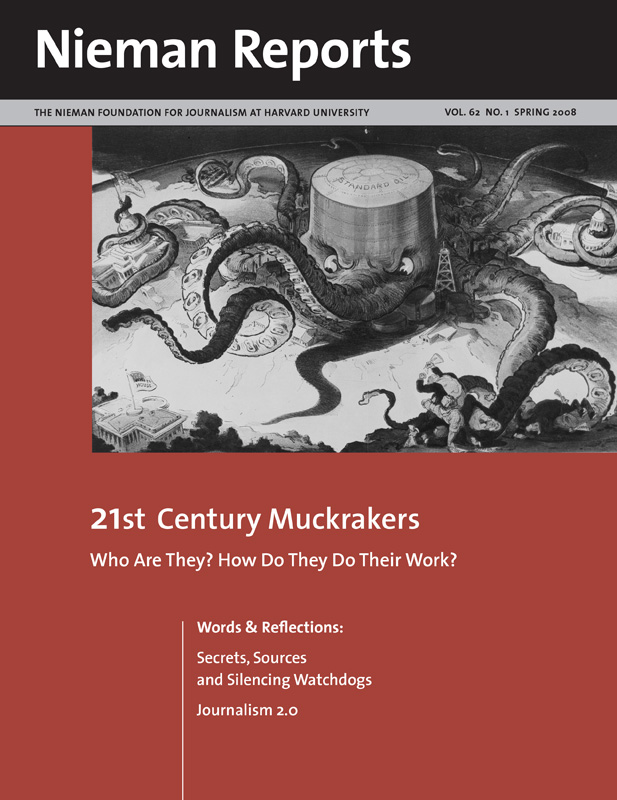RELATED ARTICLE
“Seeking New Ways to Nurture the Capacity to Report”
– Charles Lewis For three years, I have been conducting research for a new book about truth, power and the role of journalism today. In the summer of 2005, for a chapter about the Iraq War, I asked researchers, led by Mark Reading-Smith, at the Fund for Independence in Journalism, to begin tracking every single utterance by eight of the top U.S. officials (President George W. Bush, Vice President Dick Cheney, Secretary of State Colin Powell, Secretary of Defense Donald Rumsfeld, Deputy Secretary of Defense Paul Wolfowitz, National Security Advisor Condoleezza Rice, and White House press secretaries Ari Fleischer and Scott McClellan) made from September 11, 2001 through September 11, 2003, regarding Iraq’s weapons of mass destruction (WMD) and the al-Qaeda-Saddam Hussein-Iraq link. Since 2004, numerous government reports have conclusively found there were no WMD in Iraq and no significant al-Qaeda ties to Iraq.
Their analysis found that 935 false statements were made by these top officials over the two years. The number of statements spiked dramatically upward in the weeks prior to the Iraq War resolution vote in October 2002 and before the November 2002 mid-term elections, and were twice as high in the January-March 2003 days before the invasion of Iraq. Separately, for context, they gleaned revelatory material from more than 25 government, whistleblower and credible journalist-reported books about this subject, published between 9/11 and the end of 2007. The summary report, written by Lewis and Reading-Smith, and the unprecedented 380,000-word, online searchable, public and private Iraq War chronology, including the public statements interlaced with the internal knowledge, discussions, doubts and dissent known at the time, was offered to the Center for Public Integrity (www.publicintegrity.org) for public release.
For the first time, five years after the start of the Iraq War, journalists and citizens can view what the most prominent Bush administration officials said publicly, juxtaposed against what they knew internally, day to day, prior to the March 19, 2003 invasion of Iraq.
“Seeking New Ways to Nurture the Capacity to Report”
– Charles Lewis For three years, I have been conducting research for a new book about truth, power and the role of journalism today. In the summer of 2005, for a chapter about the Iraq War, I asked researchers, led by Mark Reading-Smith, at the Fund for Independence in Journalism, to begin tracking every single utterance by eight of the top U.S. officials (President George W. Bush, Vice President Dick Cheney, Secretary of State Colin Powell, Secretary of Defense Donald Rumsfeld, Deputy Secretary of Defense Paul Wolfowitz, National Security Advisor Condoleezza Rice, and White House press secretaries Ari Fleischer and Scott McClellan) made from September 11, 2001 through September 11, 2003, regarding Iraq’s weapons of mass destruction (WMD) and the al-Qaeda-Saddam Hussein-Iraq link. Since 2004, numerous government reports have conclusively found there were no WMD in Iraq and no significant al-Qaeda ties to Iraq.
Their analysis found that 935 false statements were made by these top officials over the two years. The number of statements spiked dramatically upward in the weeks prior to the Iraq War resolution vote in October 2002 and before the November 2002 mid-term elections, and were twice as high in the January-March 2003 days before the invasion of Iraq. Separately, for context, they gleaned revelatory material from more than 25 government, whistleblower and credible journalist-reported books about this subject, published between 9/11 and the end of 2007. The summary report, written by Lewis and Reading-Smith, and the unprecedented 380,000-word, online searchable, public and private Iraq War chronology, including the public statements interlaced with the internal knowledge, discussions, doubts and dissent known at the time, was offered to the Center for Public Integrity (www.publicintegrity.org) for public release.
For the first time, five years after the start of the Iraq War, journalists and citizens can view what the most prominent Bush administration officials said publicly, juxtaposed against what they knew internally, day to day, prior to the March 19, 2003 invasion of Iraq.



